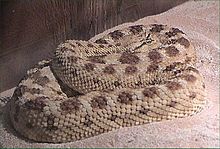Cerastes (genus)
| Cerastes | |
|---|---|
 |
|
| Desert horned viper, C. cerastes | |
| Scientific classification | |
| Kingdom: | Animalia |
| Phylum: | Chordata |
| Class: | Reptilia |
| Order: | Squamata |
| Suborder: | Serpentes |
| Family: | Viperidae |
| Subfamily: | Viperinae |
| Genus: |
Cerastes Laurenti, 1768 |
| Synonyms | |
Cerastes is a genus of small, venomous vipers found in the deserts and semi-deserts of northern North Africa eastward through Arabia and Iran. Three species are currently recognized by "ITIS" (Integrated Taxonomic Information System), and an additional recently described species is recognized by the Reptile Database. Common names for members the genus include horned vipers,North African desert vipers, and cerastes vipers.
Cerastes are small snakes, averaging less than 50 cm (20 in) in total length (body + tail), but are relatively stout in appearance. The head is broad, flat and distinct from the neck. The head is covered with tubercularly keeled scales, which usually number 15 or more across, and a supraorbital horn may be present over each eye in some species. The snout is short and wide and the eyes, which are set well forward, are small to moderate in size. The body is short, stout and cylindrically depressed. The tail is short and tapers abruptly behind the vent. The dorsal scales are small, keeled, in 23-35 rows at midbody, with the keels of the oblique lateral row being serrated.
Although Cerastes are often referred to as horned vipers, only the two larger species, C. cerastes and C. gasperettii, are known to have horns, and even these do not always have them. Individuals with and without horns occur within the same population and even within the same litter.
When present, each horn consists of a single long, spine-like scale that can be folded back into an indentation in the . They fold back in response to direct stimulation, thus streamlining the head and easing passage through burrows. Horns occur more often in individuals from sandy deserts as opposed to stony deserts. Specimens without horns have a prominent brow ridge instead.
The purpose of the horns is the subject of much speculation. One theory is that they allow a buildup of sand above the eyes while keeping it out of the eyes themselves. Another, more recent theory is simply that the horns serve to break up the outline of the head, making them harder for prey animals to spot.
They are found in North Africa eastward through Arabia and Iran. Mallow et al. (2003) describe the genus as being restricted to the deserts of North Africa and southwestern Asia, with the Negev desert acting as a filter zone between the three species mentioned in the table below.
...
Wikipedia
